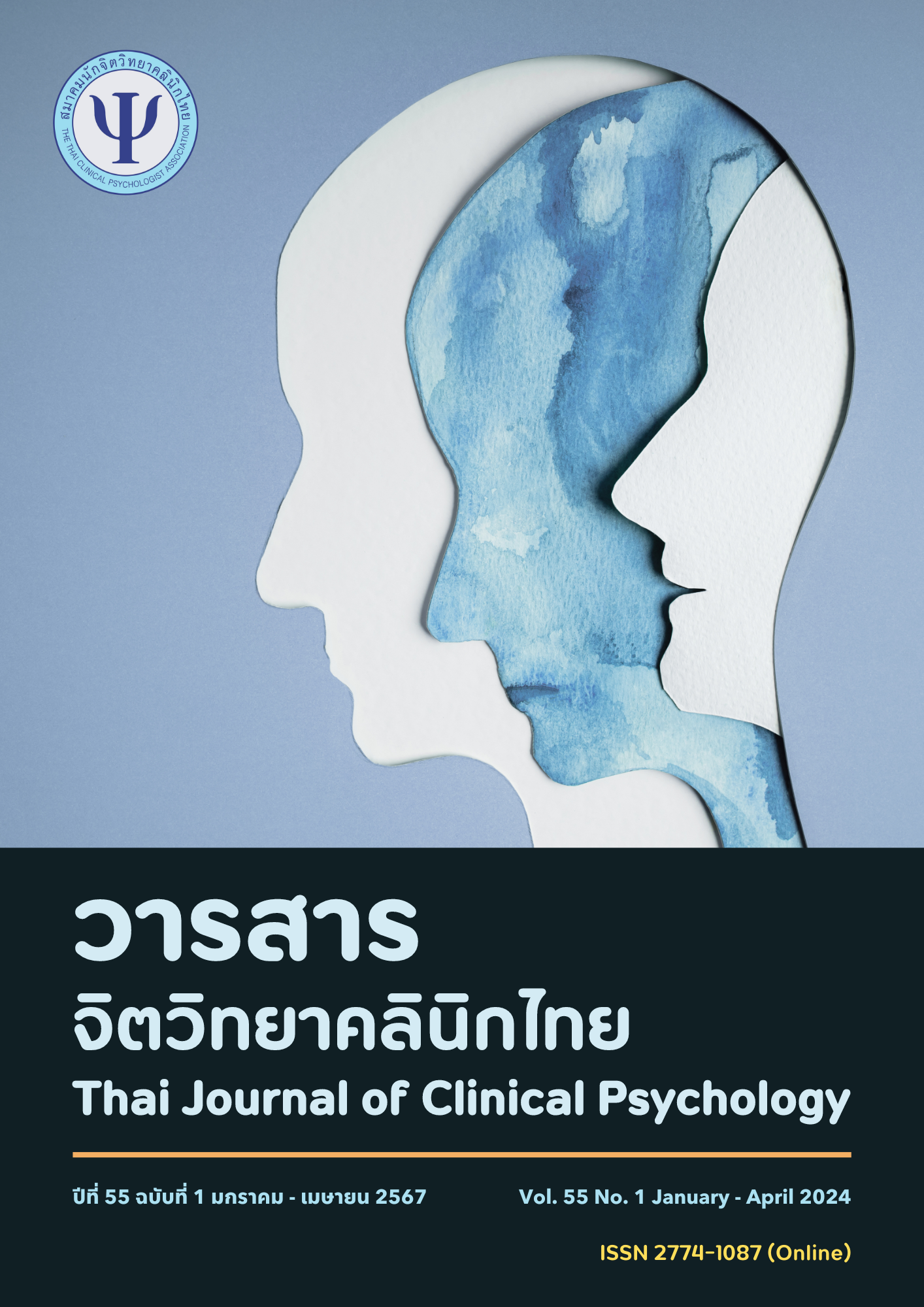อิทธิพลของการรับเอามุมมองทางลบต่อการรักเพศเดียวกันมาเป็นส่วนหนึ่งของตนต่อภาวะซึมเศร้าผ่านการเปิดเผยเพศวิถีและการรับรู้การกีดกันในคนกลุ่มน้อยทางเพศวิถี
Main Article Content
บทคัดย่อ
วัตถุประสงค์ การศึกษานี้มีวัตถุประสงค์เพื่อศึกษาความสัมพันธ์ระหว่างการรับเอามุมมองทางลบต่อการรักเพศเดียวกันมาเป็นส่วนหนึ่งของตนกับภาวะซึมเศร้า โดยมีการเปิดเผยเพศวิถีและการรับรู้การกีดกันเป็นกลไกที่ร่วมอธิบายความสัมพันธ์ วัสดุและวิธีการ การศึกษาเชิงสำรวจแบบภาคตัดขวาง เก็บข้อมูลในคนกลุ่มน้อยทางเพศวิถีจำนวน 263 คน ผ่านการตอบแบบวัดรายงานตนเองของตัวแปรที่ศึกษาทางออนไลน์และวิเคราะห์ข้อมูลโดยการวิเคราะห์เส้นทางอิทธิพล ผลการศึกษา โมเดลสมมติฐานมีความสอดคล้องกับข้อมูลจากหลักฐานเชิงประจักษ์ พบอิทธิพลทางตรงและอิทธิพลทางอ้อมอย่างมีนัยสำคัญทางสถิติของการรับเอามุมมองทางลบต่อการรักเพศเดียวกันมาเป็นส่วนหนึ่งของตนต่อภาวะซึมเศร้า โดยพบอิทธิพลทางบวกของการรับเอามุมมองทางลบต่อการรักเพศเดียวกันมาเป็นส่วนหนึ่งของตนต่อภาวะซึมเศร้าในทางตรงและอิทธิพลทางอ้อมผ่านการรับรู้การกีดกันไปยังภาวะซึมเศร้า รวมถึงอิทธิพลทางอ้อมผ่านการเปิดเผยเพศวิถีและการรับรู้การกีดกันไปยังภาวะซึมเศร้า สรุป การวิจัยครั้งนี้เป็นการศึกษาในลำดับต้นๆ ที่ศึกษาความสัมพันธ์ระหว่างการรับเอามุมมองทางลบต่อการรักเพศเดียวกันมาเป็นส่วนหนึ่งของตน ภาวะซึมเศร้า การเปิดเผยเพศวิถี และการรับรู้การกีดกันของคนกลุ่มน้อยทางเพศวิถีในไทย ข้อค้นพบจากการศึกษาสามารถนำมาใช้ต่อยอดในการส่งเสริมประสิทธิภาพของการทำงานเชิงจิตวิทยาทั้งในแง่ของการป้องกันและการบำบัดภาวะซึมเศร้าในคนกลุ่มน้อยทางเพศวิถี
Article Details

This work is licensed under a Creative Commons Attribution-NonCommercial-NoDerivatives 4.0 International License.
เรื่องที่ลงตีพิมพ์ในวารสารจิตวิทยาคลินิกแล้วถือเป็นลิขสิทธิ์การเผยแพร่โดยวารสารจิตวิทยาคลินิกแต่เพียงผู้เดียว การตีพิมพ์หรือเผยแพร่ซ้ำในที่อื่นต้องได้รับอนุญาตจากกองบรรณาธิการวารสารฯ
References
Almeida, J., Johnson, R. M., Corliss, H. L., Molnar, B. E., & Azrael, D. (2009). Emotional distress among LGBT youth: The influence of perceived discrimination based on sexual orientation. Journal of Youth and Adolescence, 38(7), 1001-1014. https://doi.org/10.1007/s10964-009-9397-9
American Psychological Association. (2019, October 31). Discrimination: What it is, and how to cope. https://www.apa.org/topics/racism-biasdiscrimination/types-stress
Anxiety and Depression Association of America. (n.d.). LGBTQ+ Communities. Retrieved July 1, 2021, from https://adaa.org/lgbtq-communities.
Balsam, K. F., Beadnell, B., & Molina, Y. (2013). The daily heterosexist experiences questionnaire: Measuring minority stress among lesbian, gay, bisexual, and transgender adults. Measurement and Evaluation in Counseling and Development,46(1), 3-25. https://doi.org/10.1177/0748175612449743
Beck, A. T. (1979). Cognitive therapy of depression. Guilford Press.
Brislin, R. W. (1970). Back-translation for crosscultural research. Journal of Cross-Cultural Psychology, 1(3), 185-216. https://doi.org/10.1177/135910457000100301
Cass, V. C. (1979). Homosexual identity formation: A theoretical model. Journal of Homosexuality, 4(3), 219-235. https://doi.org/10.1300/J082v04n03_01
Chang, C. J., Kellerman, J. K., Fehling, K. B., Feinstein, B. A., & Selby, E. A. (2021). The roles of discrimination and social support in the associations between outness and mental health outcomes among sexual minorities. American Journal of Orthopsychiatry, 91(5), 607. https://psycnet.apa.org/doi/10.1037/ort0000562
Dohrenwend, B. P. (1998). Adversity, stress, and psychopathology. Oxford University Press.
Garson, D. (2008). Path analysis. North Carolina State University.
Gilbert, P. (2007). Psychotherapy and counselling for depression. Sage.
Health Data Center. (n.d.). Depression service access report. Thailand Ministry of Public Health, Digital Government Development Agency, Retrieved July 1, 2021, from https://hdcservice.moph.go.th/hdc/reports/report.php?source=pformated/formatg.php&cat_id=ea11bc4bbf333b78e6f53a26f7ab6c89&id=706b605192b49d385ba044350af9c46a (in Thai).
Heim, C., Newport, D. J., Mletzko, T., Miller, A. H., & Nemeroff, C. B. (2008). The link between childhood trauma and depression: Insights from HPA axis studies in humans. Psychoneuroendocrinology, 33(6), 693-710. https://doi.org/10.1016/j.psyneuen.2008.03.008
Herek, G. M. (2004). Beyond “homophobia”: Thinking about sexual prejudice and stigma in the twenty-first century. Sexuality Research & Social Policy, 1(2), 6-24. https://doi.org/10.1525/srsp.2004.1.2.6
Herek, G. M., Cogan, J. C., Gillis, J. R., & Glunt, E. K. (1998). Correlates of internalized homophobia in a community sample of lesbians and gay men. Journal-Gay and Lesbian Medical Association, 2(1), 17-26.
Jarernpanit, T., Ma, Q., & Wang, Y. (2019). The gender issues and identities of the young tomboy and lesbian in Chiang Mai and Phitsanulok of Thailand. Life Sciences and Environment Journal, 20(1), 172-184. https://ph01.tci-thaijo.org/index.php/psru/article/view/165948 (in Thai).
King, M., Semlyen, J., Tai, S. S., Killaspy, H., Osborn, D., Popelyuk, D., & Nazareth, I. (2008). A systematic review of mental disorder, suicide, and deliberate self-harm in lesbian, gay and bisexual people. BMC Psychiatry, 8(1), 1-17.
https://doi.org/10.1186/1471-244X-8-70
Kittiteerasack, P., Steffen, A., & Matthews, A. (2020). The influence of minority stress on level of depression among Thai LGBT Adults. Nursing Journal of Indonesia, 23, 74-84. https://doi.org/10.7454/jki.v23i1.1073
Lee, H., Park, J., Choi, B., Yi, H., & Kim, S.-S. (2021). Association between discrimination and depressive symptoms among 2,162 lesbian, gay, and bisexual adults in South Korea: Does community connectedness modify the
association? Journal of Homosexuality. 68(1), 70-87, https://doi.org/10.1080/00918369.2019.1624456
Mayfield, W. (2001). The development of an internalized homonegativity inventory for gay men. Journal of Homosexuality, 41(2), 53-76. https://doi.org/10.1300/J082v41n02_04
Mays, V. M., & Cochran, S. D. (2001). Mental health correlates of perceived discrimination among lesbian, gay, and bisexual adults in the United States. American Journal of Public Health, 91(11), 1869-1876. https://doi.org/10.2105/
AJPH.91.11.1869
Meyer, I. H. (1995). Minority stress and mental health in gay men. Journal of Health and Social behavior, 38-56. https://doi.org/10.2307/2137286
Meyer, I. H. (2003). Prejudice, social stress, and mental health in lesbian, gay, and bisexual populations: conceptual issues and research evidence. Psychological Bulletin, 129(5), 674. https://doi.org/10.1037/0033-2909.129.5.674
National Mental Health Institution. (2023, July).Major Depression. https://www.nimh.nih.gov/health/statistics/major-depression
Newcomb, M. E., & Mustanski, B. (2010). Internalized homophobia and internalizing mental health problems: A meta-analytic review. Clinical Psychology Review, 30(8), 1019-1029. https://doi.org/10.1016/j.cpr.2010.07.003
Radloff, L. S. (1977). The CES-D scale: A self-report depression scale for research in the general population. Applied Psychological Measurement, 1(3), 385-401. https://doi.org/10.1177/014662167700100306
Riggle, E. D. B., Rostosky, S. S., Black, W. W., & Rosenkrantz, D. E. (2017). Outness, concealment, and authenticity: Associations with LGB individuals’ psychological distress and wellbeing. Psychology of Sexual Orientation and
Gender Diversity, 4(1), 54–62. https://doi.org/10.1037/sgd0000202
Roberts, N. L., Mountjoy-Venning, W. C., Anjomshoa, M., Banoub, J. A. M., & Yasin, Y. J. (2019). GBD 2017 Disease and injury incidence and prevalence collaborators. global, regional, and national incidence, prevalence, and years
lived with disability for 354 diseases and injuries for 195 countries and territories, 1990-2017: A systematic analysis for the global burden of disease study. Lancet, 393(10190). https://doi.org/10.1016/S0140-6736(18)32279-7
Sacco, A., Pössel, P., & Roane, S. J. (2023). Perceived discrimination and depressive symptoms: What role does the cognitive triad play? Journal of Clinical Psychology, 79, 985-1001. https://doi.org/10.1002/jclp.23452
Sahassanon, P. (2015). The effect of cognitive behavior group therapy with art as a medium on depressive symptoms and antiretroviral medical adherence in MSM with HIV infection [Master’s thesis, Chulalongkorn University].
Chulalongkorn University Intellectual Repository (CUIR). http://doi.org/10.14457/CU.the.2015.815 (in Thai).
Schotte, C. K., Van Den Bossche, B., De Doncker, D., Claes, S., & Cosyns, P. (2006). A biopsychosocial model as a guide for psychoeducation and treatment of depression. Depression and Anxiety, 23(5), 312-324. https://doi.org/
1002/da.20177
Sullivan, P. F., Neale, M. C., & Kendler, K. S. (2000). Genetic epidemiology of major depression: Review and meta-analysis. American Journal of Psychiatry, 157(10), 1552-1562. https://doi.org/10.1176/appi.ajp.157.10.1552
United Nations Development Programme. (2014). Being LGBT in Asia: Thailand country report. UNDP Asia-Pacific Regional Centre.
United Nations Development Programme. (2019). Tolerance but not inclusion: A national survey on experiences of discrimination and social attitudes towards LGBT people in Thailand. UNDP Asia-Pacific Regional Centre.
Walch, S. E., Ngamake, S. T., Bovornusvakool, W., & Walker, S. V. (2016). Discrimination, internalized homophobia, and concealment in sexual minority physical and mental health. Psychology of Sexual Orientation and Gender
Diversity, 3(1), 37. https://doi.org/10.1037/sgd0000146

